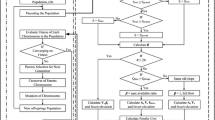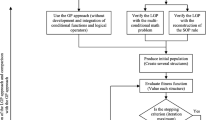Abstract
In this study, the impacts of different crossover and encoding schemes on the performance of a genetic algorithm (GA) in finding optimal pump-and-treat (P&T) remediation designs are investigated. For this purpose, binary and Gray encodings of the decision variables are tested. Uniform and two-point crossover schemes are evaluated for two different crossover probabilities. Analysis is performed for two P&T system optimization scenarios. Results show that uniform crossover operator with Gray encoding outperforms the other alternatives for the complex problem with higher number of decision variables. On the other hand, when a simpler problem, which had a lower number of decision variables, is solved, the efficiency of GA is independent of the encoding and crossover schemes.
Similar content being viewed by others
References
Aksoy A, Culver TB (2004) Impact of physical and chemical heterogeneities on aquifer remediation design. J Water Resour Plan Manag 130:311–320
Andre J, Siarry P, Dognon T (2001) An improvement of the standard genetic algorithm fighting premature convergence in continuous optimization. Adv Eng Softw 32:49–60
Ashlock D (2000) Evolutionary computation for modeling and optimization. Springer, New York
Bethke AD (1981) Genetic algorithms as function optimizers. Dissertation, Univ of Michigan
Caruana RA, Schaffer JD (1988) Representation and hidden bias: Gray vs. binary coding for genetic algorithms. In: Laird J (ed) Proceedings of the 5th international conference on machine learning. University of Michigan, Ann Arbor, pp 153–161
Chakraborty UK, Janikow CZ (2003) An analysis of Gray versus binary encoding in genetic search. Inf Sci 156:253–269
Chan Hilton AB, Culver TB (2000) Constraint handling for genetic algorithms in optimal remediation design. J Water Resour Plan Manag 126:128–137
Chan Hilton AB, Culver TB (2005) Groundwater remediation design under uncertainty using genetic algorithms. J Water Resour Plan Manag 131:25–34
Chipperfield A (1997) Introduction to genetic algorithms. In: Zalzala AMS, Fleming PJ (eds) Genetic algorithms in engineering systems. IEE control engineering series, vol 55. The Institution of Electrical Engineers, Stevenage, pp 1–45
Culver TB, Earles TA, Gray JP (1996) Numerical modeling of in situ bioremediation with sorption kinetics. DAAL03-91-C-0034; TCN95-066, US Army Research Office, North Carolina
De Jong KA, Spears WM (1992) A formal analysis of the role of multi-point crossover in genetic algorithms. Ann Math Artif Intell 5:1–26
Dumitrescu D, Lazzerini B, Jain LC, Dumitrescu A (2000) International series of computational intelligence, evolutionary computation. CRC Press, Boca Raton
Earles TA (1996) Modeling rate limited sorption. Dissertation, Univ of Virginia
Eshelman LJ, Caruana R, Schaffer JD (1989) Biases in the crossover landscape. In: Schaffer JD (ed) Proceedings of the 3rd international conference on genetic algorithms, George Mason University, Fairfax, pp 10–19
Fang T, Ball JE (2007) Evaluation of spatially variable control parameters in a complex catchment modelling system: a genetic algorithm application. J Hydroinform 9:163–173
Guyaguler B, Horne R (2000) Optimization of well placement. J Energy Resour Technol 122:64–70
Haupt RL, Haupt SE (1998) Practical genetic algorithms. Wiley, New York
Holland JH (1975) Adaptation in natural and artificial systems: an introductory analysis with applications to biology, control, and artificial intelligence. University of Michigan Press, Ann Arbor
Hollstien RB (1971) Artificial genetic adaptation in computer control systems. Diss Abstr Int B 32:1510
Levine D (1996) Users guide to the PGAPack parallel genetic algorithm library. ANL-95/18, Argonne National Laboratory, Argonne
Liu W, Medina M, Thomann W Jr, Piver WT, Jacobs TL (2000) Optimization of intermittent pumping schedules for aquifer remediation using genetic algorithm. J Am Water Resour Assoc 36:1335–1348
Mathias KE, Whitley LD (1994) Transforming the search space with Gray coding. In: Proceedings of the 1st IEEE international conference on evolutionary computation. IEEE Press, New York, pp 513–518
McKinney DC, Lin MD (1994) Genetic algorithm solution of groundwater management models. Water Resour Res 30:1897–1906
Mitchell M (1996) An introduction to genetic algorithms. MIT Press, Cambridge
Reeves CR, Rowe JE (2003) Genetic algorithms: principles and perspectives, a guide to GA theory. Kluwer Academic, Dordrecht
Rowe J, Whitley D, Barbulescu L, Watson JP (2004) Properties of Gray and binary representations. Evol Comput 12:47–76
Sharma SK, Irwin GW (2003) Fuzzy coding of genetic algorithms. IEEE Trans Evol Comput 7:344–355
US Environmental Protection Agency (USEPA) (2001) Cost analyses for selected groundwater cleanup projects: pump and treat systems and permeable reactive barriers. Solid Waste and Emergency Response, EPA-542-R-00-013
Vekaria K, Clack C (1998) Selective crossover in genetic algorithms: an empirical study. In: Eiben AE, Bäck T, Schoenauer M, Schwefel HP (eds) Proceedings of the 5th conference on parallel problem solving from nature. Springer, Berlin, pp 438–447
Wardlaw R, Sharif M (1999) Evaluation of genetic algorithms for optimal reservoir operation. J Water Resour Plan Manag 125:2533
Weck B, Karr CL, Freeman LM (1999) Gauss-Legendre integration using genetic algorithms. In: Karr CL, Freeman LM (eds) International series of computational intelligence, industrial applications of genetic algorithms. CRC Press, Boca Raton, pp 243–256
Wilf HS (1989) Combinatorial algorithms: an update. CBMS-NSF regional conference series in applied mathematics, vol 55. Society of Industrial and Applied Mathematics, Philadelphia
Zheng C, Wang P (2002) A field demonstration of the simulation optimization approach for remediation system design. Ground Water 40:258–265
Author information
Authors and Affiliations
Corresponding author
Rights and permissions
About this article
Cite this article
Güngör-Demirci, G., Aksoy, A. Evaluation of the genetic algorithm parameters on the optimization performance: a case study on pump-and-treat remediation design. TOP 18, 303–320 (2010). https://doi.org/10.1007/s11750-010-0154-8
Received:
Accepted:
Published:
Issue Date:
DOI: https://doi.org/10.1007/s11750-010-0154-8




